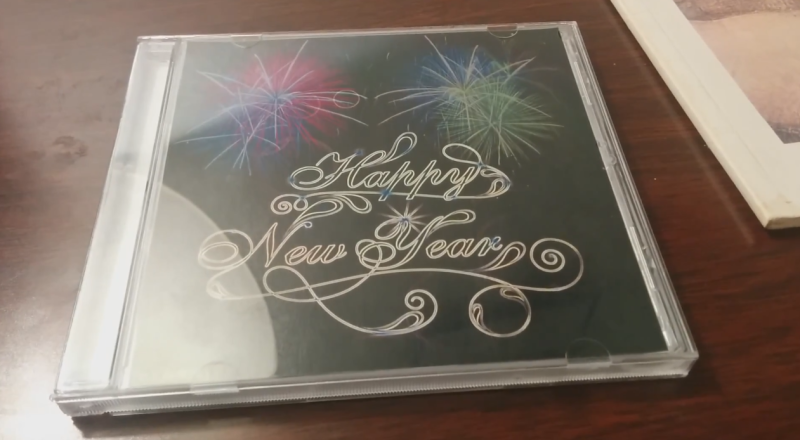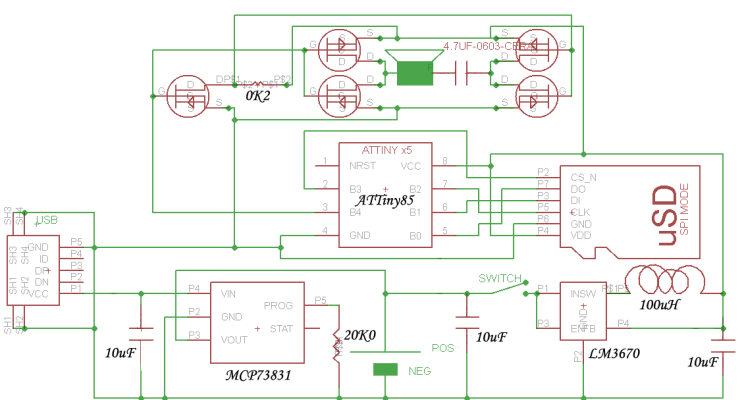We’ve all heard the terrible greeting cards that have soundbites of 2 bit jingles that usually make you want to tear the battery out… but Hallmark is finally catching up with technology and now including real music in their cards — it might only be about 10 seconds, but hey, it’s a step!
They’re still pretty corny though, and we’re not really sure what even dictates an ideal situation to give someone an audible greeting card — but regardless, [Dmitry Grinberg] thought he could do better than Hallmark — and we’d have to agree. He’s created a New Year’s Greeting card using a CD jewel case, and what he’s packed inside is pretty incredible.
The case, when opened, will play a full-length song in full fidelity. Next time you open it, it’ll play something new and at random, from its very own micro SD card 300-song library.
He’s achieved this using an ATTiny85 which uses two timers clocked at 64MHz and 32KHz to output the analog musical goodness. He’s also packed a micro USB charger in the case with a thin Li-Po battery, an SD card adapter soldered in place to allow for swapping of music files on the microSD, and the speaker plus amplifiers. When closed you can’t even tell there is something different about the case.
Pretty cool project. And he’s even thrown up the code (available on his site) if you’re interested in trying your own!
For an even more minimalist circuit, how about a single chip greeting card that might actually be cheaper than Hallmark’s offering? Or why not throw in some nice visual effects with a edge-lit musical greeting card?

















Neat project, but the amplifier is wasteful (out of necessity from too few pins). Ignoring the turn on and turn off delays, the speaker still drives constantly. Say it takes one watt at full power, it still takes one watt at no power (50% duty cycle), if I am not misunderstanding the article. I would personally use just one FET and deal with driving the speaker in only one polarity.
Don’t forget that the coil is inductive. The power dissipation at the carrier frequency is surprisingly small.
It’s not wasteful. Well, this particular one might be a little, since I have no idea if the relatively low switching frequency is high enough to see significant impedance from a speaker that small, but this is a fairly standard method to controlling an h-bridge. It’s also easier for the microcontroller to handle from a software perspective; since there’s no separate line to control the direction of the bridge, it’s also not necessary for the CPU to handle the zero-crossing and level inversion that would be necessary with the more-familiar sign/magnitude method.
It does not really drive constantly.
no DC current through it thanks to the series cap.
and as an inductor, it does not pass much of the 256khz through either.
the real inefficiency is that the FET on times overlap
Can someone figure out how to rescue “dead” 8GB microSD cards, because I am pretty sure that the memory chips are OK on most of them as the external controller seems to be at fault.
PC still sees the chip but they read as 0 bytes or in some cases 1K depending on the brand.
On the back of the card there are dozens of tiny contacts under the label so perhaps this approach might work?
I had some success with 32GB and 16GB AD**A ones where they went read only but the chip still otherwise worked.
Ones which would not format were also responsive to this method :-)
Seems that high density cells are more susceptible to <15kev than normal, because putting them 5mm away from an energized 5642 rectifier tube brought them back to life.
http://hackaday.com/2013/08/19/rescuing-an-sd-card-with-an-arduino/
I have not tried that, but i do have a broken card, which i intend to try to rescue.
put in the freezer then take it out as quick as possible and plug it in see if that helps
put reader in freezer ?
It;s not a HD
It’s a great Idea, we can give our elderly and musically interested people a stocking suffer that can be customized to them…we can sort of do it now but Metallica might beat our asses…..lol @ bother said pooh… stick a stun gun to it…..it won’t help but tell me what happens….probably fries….I hate technology…sort of…this statement s suddenly ironic…not being on print….dammit….
He’s achieved this using an ATTiny85 which uses two timers clocked at 64MHz and 32KHz..
Must be a typo?
Probably not. It’s common to have two clocks available for driving the CPU. A main clock running at a Mhz speed, often higher than that of the instruction speed. And a secondary clock running at Khz, which you switch the CPU to for executing instructions slowly in low-power mode; since CMOS draws little power except when logic states change, and the clock drives most changes. For the latter, 32.768Khz is often used since watch crystals are cheaply and widely available at that frequency, should you need precision timekeeping in low-power mode. Calling them timers rather than clocks is a bit of a misnomer, but close enough.
Atmel’s site shows the max frequency of the ATtiny85 at 20 MHz. I know they can be overclocked a bit, but over 3X it’s max???
http://www.atmel.com/devices/attiny85.aspx
Attiny has a pll that can be used to clock timer 1 at 64mhz. It is divided by 4 to clock the cpu itself at 16mhz. Timer 0 is used for 32khz interrupt
if he is trying to one better than Hallmark, he seems to have succeeded based on audio quality, length, and variety.
However, with a a (micro)SD Card, containing 300 songs, it might be a clever way of sharing music.
For production versions, I would eliminate any external media, and use an internal nand-flash or similar product — although a technically inclined, or determined, person could still rip the songs of the flash.
However, the average person would not know how to do that.
reminds me of tristian pirchs 1 bit symphony
http://vimeo.com/12244413
perich – sorry for the typo